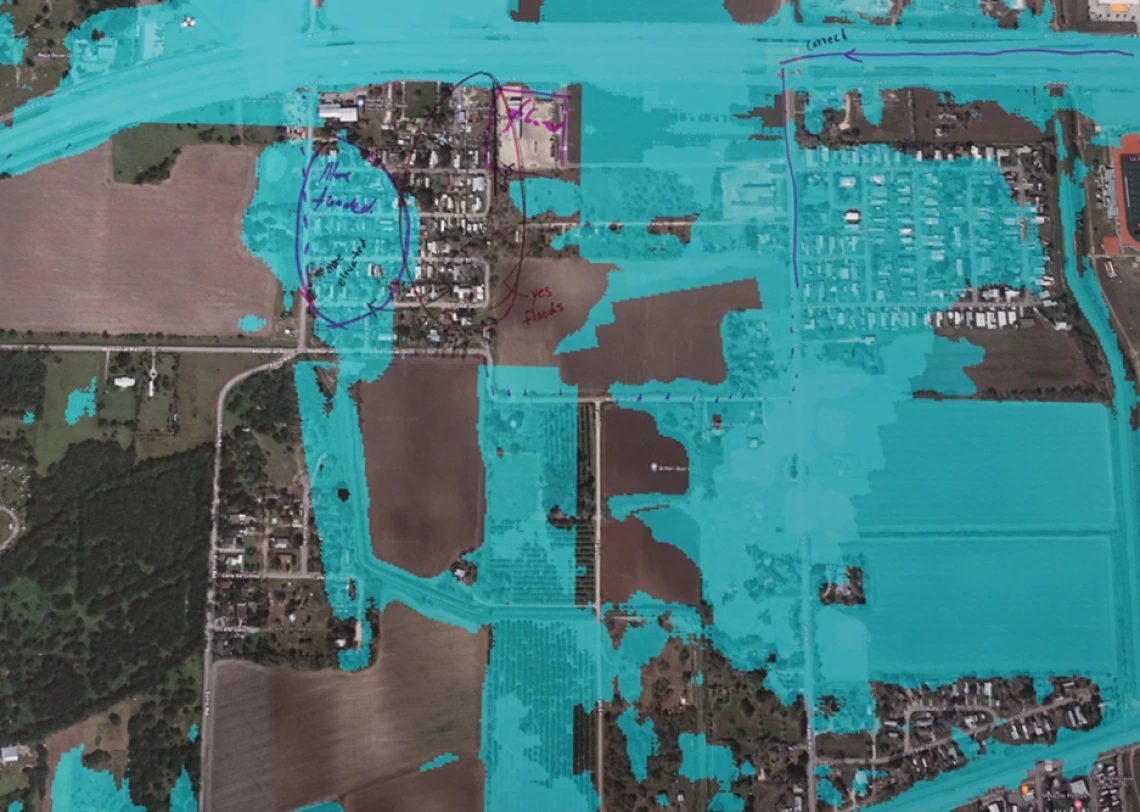You’re not the Hero of this Story

Participatory map from workshop #2 (January, 2024)
The FLUJOS RGV (Flood Justice Utilizing Satellite Observation – Rio Grande Valley) project launched in May 2023. Now, as I reflect on the last year, I’m struck by the surprising yet powerful lessons I learned about community collaboration, science communication, and environmental justice research. The three core lessons are:
- Participatory Research Takes Time.
- Partners Want More, not Less.
- Collaboration Requires Decentering.
Participatory Research Takes Time
The research team and I originally conceived FLUJOS RGV as a 12-month project to develop locally validated flood data using satellite imagery and the experiences of flood-vulnerable colonia residents. Using a co-production framework, which views local stakeholders as equal knowledge holders to researchers, we aimed to build this research project collaboratively. Co-production is a participatory research method, and for me a more ethical manner of social science, that centers research agendas on the needs of on-the-ground partners. Here’s the catch, co-production takes a long time. Building trust and setting expectations required near-weekly calls to understand the diverse needs and expectations of our collaborators, co-develop funding proposals, and plan and execute participatory workshops. These meetings and workshops were crucial for building trust and developing interpersonal relationships yet took considerably more time than anticipated.
In addition to building trust, we also engaged in knowledge sharing. Not only were we teaching our collaborators about mapping flooding with machine learning algorithms applied to satellite imagery, but they were teaching us about the local flood dynamics that the community experienced and the broader ecosystem of flood vulnerability in the region. From our side, we needed our partners to understand the limitations of our research (e.g., satellites can’t see flooded basements or flash floods that dissipate before a satellite can pass overhead). Conversely, our partners detailed their contentious relationships with local and federal government entities. This context deepened our understanding of the political dimensions of RGV flood dynamics.
Partners Want More, not Less
The time invested in the co-production process established trust, built community relations, and centered our research around the aims of our partner organizations. As a result, our partners’ interest in collaboration grew, leading to an increase in the scope and scale of the project. For example, we initially approached our community partners with trepidation hoping they could connect us with 40 flood vulnerable residents, knowing this would require significant labor on their part. Rather than reluctance, our partners were unhappy with the low number and wanted us to work with closer to 100 residents. Shifting the scale of the project required us to reconsider the budget of the project and shift our focus to increase direct resident engagement.
In another example, after explaining the technical scope of the project’s end goal – the development of a locally validated flood database – one community partner asked, at what point the project would also focus on other public health concerns? I responded that unfortunately that was currently out of the scope of our project, but if that was a priority then perhaps another phase of the project (year 2 or 3) might incorporate the mapping of public health indicators.
This shift in scope and scale reflects both the relationships this project has built with organizations and the need for environmental justice scholarship to provide support to directly address the stated needs of on-the-ground collaborators. In this case, we hope to provide flood maps that our collaborators can use in grant applications, to pressure the state (local, state, and federal government) to provide flood mitigation infrastructure, and to potentially provide evidence for lawsuits.
Collaboration Requires Decentering
Perhaps the most difficult concept I’ve struggled with this year is humility. My understanding of humility isn’t about narcissism, but rather letting go of the belief that I should always have the answer and recognizing that there is power in admitting ignorance. Another element of humility is acknowledging that mistakes will inevitably happen. In the last year, the research team sometimes didn’t communicate clearly and confused our collaborators, delayed our second workshop by two months, and missed a major grant deadline. These mistakes (among others) left me with a profound sense of failure predicated on the belief that I am supposed to solve problems. As I verbalized this sense of failure to a colleague they responded, Lucas – you aren’t the hero of this story.
To me, that was a profound moment. Racialized flood injustice is a deeply entrenched problem in the RGV and community-based organizations have challenged this issue for decades. Likely they will continue this fight for decades to come. And while it would be easy (and cliché) to say that ‘these advocates are the real heroes’ I would argue that, in fact, the ultimate ‘hero’ of this story isn’t a single individual or institution – it’s a collective and community-centered effort to challenge entrenched and racialized environmental injustice. While I do this work in the hope that improved flood data will better situate these organizations to challenge flood injustice, I will never have all the answers or solve the problems.
Fortunately, despite these errors, we have worked hard and taken considerable time developing relationships in this community. Mistakes happen, and they will continue to happen. I think the true aim of this participatory research project is developing trust with community partners so that mistakes can be forgiven and that, together, our research supports the long and ongoing fight for flood justice in the Rio Grande Valley of South Texas. Beyond trust there are other additional beneficial outcomes from these relationships. For example, this collaboration has provided microgrants to community-based organizations. In addition, the impact of our research has also been a series of knowledge exchanges about mapping flood data as well as the risks associated with producing these maps.

